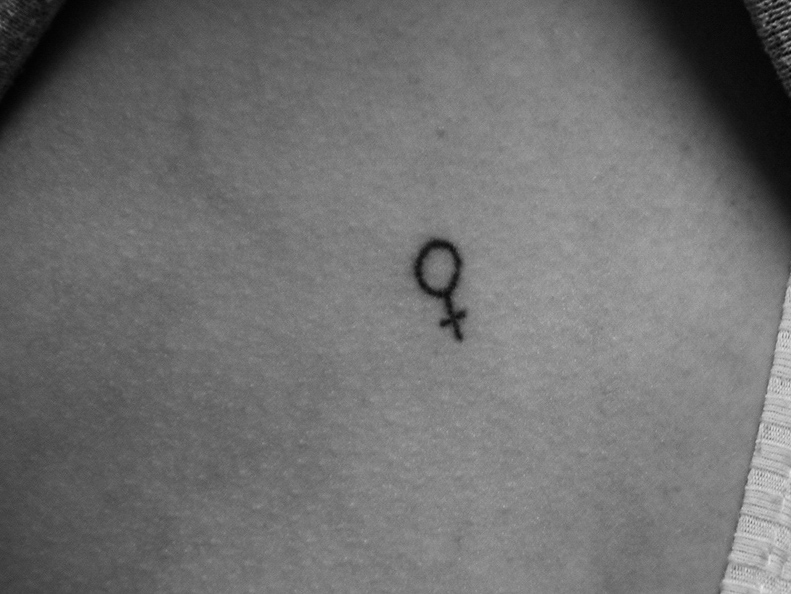Stick and poke tattoos
Some students have turned to do-it-yourself methods for tattoos. However, a local professional tattoo artist discourages the practice.
You’re over at your friends house when her sister brings out a kit she purchased online. She shaves your ankle, cleans it with rubbing alcohol and puts on gloves. Then she takes out a needle and starts poking your ankle along the design you created.
This was Kat Hagan ’20’s experience getting her first stick and poke tattoo, a small design with a copyright sign and her birth year, 2001. A month later she got one on her ribs of the symbol of Venus.
Stick and pokes refer to a “do-it-yourself” method of getting a tattoo. Methods of receiving a stick and poke range from a kit purchased online to simply a needle, thread and pen ink.
The concept of getting tattoos outside of a parlor isn’t a new one, but stick and pokes are what this practice has taken the form of for today’s students. They are said to be temporary, but local tattoo artist Mark Bell says this is not always the case.
The quality and permanency of the tattoo depends on how deep the needle goes into the skin. If it goes too deep it can cause blowout, which Bell describes as “holding a sharpie down on paper.” However, if the ink goes in too shallow it won’t hold in the skin as well. Infection is also a risk when the artist isn’t licensed and working in a professional studio.
“It’s like playing pin the tail on the donkey. Sometimes, you know, you’re just blindfolded, stabbing and hoping to get something right,” Bell said.
The method being advertised as supposedly semi-permanent is part of what makes teenager so attracted it.
“It was a little bit impulsive, but honestly, the only reason I went through with it is because I knew it wasn’t going to last forever,” Hagan said.
Another reason teens gravitate towards stick and poke is that it’s a way to express themselves without a financial or supposed time commitment.
“I think part of the reason why that is is because they actually have meaning to me,” Hagan said. “My birth year and a sign of being, you know who I am, a woman, and so I don’t regret them. I think they’re really fun.”
Ryan Gamble ’19 also started exploring tattoos through the stick and poke method. In May of 2018, a friend tattooed a palm tree on his hip using a needle with rope and pen ink. He choose the palm tree because he is from Florida and his dad grew up there. Over the past winter break Gamble went on to get his parents’ and his birth coordinates professionally tattooed on his shoulder blade.
Gamble and Hagan both thought that having meaning behind the tattoos was important before getting it placed on their body. Bell understands the appeal of this method for teenagers who want to express themselves this way.
“When you’re starting to sort of reclaim yourself and sort of starting to define yourself versus the blank slate that was given to you … it can become something really expressive, and it can become something beautiful when you’re getting tattooed,” Bell said. “And I can understand people’s desire to want to be able to start taking some of those first baby steps themselves, I can certainly also understand some people worry about the pain or the expense of a tattoo if they get started and can’t finish.”
However, people who illegally tattoo without a license for a profit — also known as “scratchers” — perpetuate negative stereotypes about the industry.
“Some of the scratchers I have a real problem with,” Bell said. “The people that are predatory on people that don’t know any better, that are trying to sell themselves as an artist and trying to guilt … somebody into letting them do a terrible tattoo on them. That bothers me a lot more than somebody that wants to try to do their own little stick and poke deal,” Bell said.
Bell has been tattooing for over 15 years. His career started off with an apprenticeship and he now owns his own studio, Indigo Body Art Gallery. Because of the time he’s invested into becoming a tattoo artist and running his business, it frustrates him to see people trying to do the job he has been trained to do a very specific way.
“It takes a certain amount of sort of perseverance, dedication, to be able to do this work day-to-day, year-to-year … there’s a lot of pride in that.” Bell said. “And to some degree, it’s offensive to think that people want to try to take that opportunity for employment away from us because they think we’re too expensive when we go to all these things to try to provide a clean and safe environment.”
Your donation will support the student journalists of West High School. Your contribution will allow us to purchase Scholarship Yearbooks, newsroom equipment and cover our annual website hosting costs.

Natalie Dunlap is a senior and the Online Editor-in-Chief for the West Side Story. She is also involved in theatre and West High Democrats. When she's...



